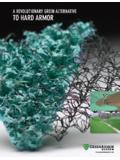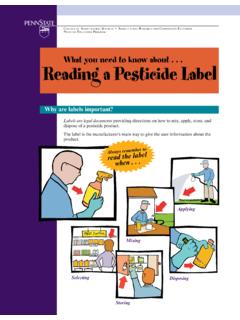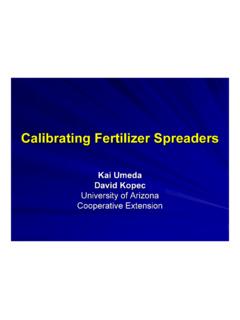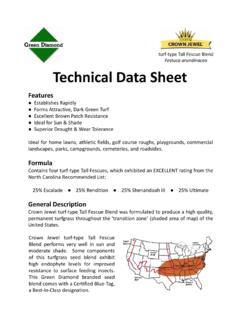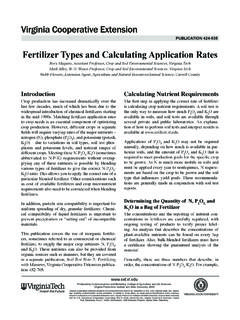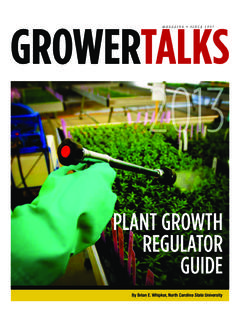Transcription of Painting dormant bermudagrass putting greens - Green …
1 86 GCM November 2007researchPainting dormant bermudagrass putting greensPainting bermudagrass greens in winter is a viable option for some Liu, McCarty, Christian M. Baldwin William G. Sarvis Steve H. Long( hectares) of greens , Painting costs would be about $6,000-$9,000 per season, which could be considerably less than the cost of overseeding, depending on the number of applications and the price of paint (1,2). Additional research is neces-sary because little information on Painting greens in winter is study had several objectives: to evalu-ate the effects of three paints, three fall mowing heights before Painting and applications of a plant growth regulator and foliar and granular fertiliz-ers on ball-roll distance in winter, soil and sur-face temperatures, spring Green -up, bermudagrass recovery and summer turf performance.
2 Materials and methodsThe study was conducted from May 2005 to May 2007 at Clemson University, Clem-son, , on TifEagle bermudagrass (Cynodon dactylon Burtt-Davey C. transvaalensis L.) established with sprigs in summer 2002 on a Green constructed according to USGA recom-mendations. Normal management practices were followed, including irrigation, fertilizer and pesticide applications. Mowing treatmentsDuring the growing season, the Green was mowed daily at inch ( millimeters) with a triplex mower. Four weeks before Painting , the research bermudagrass greens traditionally have been overseeded to provide winter color.
3 Prepara-tion for overseeding includes aggressive verticut-ting, scalping and watering and is destructive to bermudagrass greens . Although it is dormant in winter, the bermudagrass is still alive. After overseeding, the shade from the overseeded turf usually causes the bermudagrass to decline. This competition also can lead to catastrophic problems in spring transition. In the worst case, a course will transition from an overseeded cool-season grass to dead turf. Other problems associated with overseeding include the increased susceptibility of bermudagrass to diseases, increased weed pres-sure, delayed spring Green -up and the inability to remove the overseeded grass.
4 Overseeding also can be expensive. For all these reasons, superin-tendents have searched for alternatives and found a simple, quick and inexpensive way to instantly transform brown putting greens : greens recently has become the No. 1 alternative to overseeding greens for winter color. The practice is gaining popularity because it is relatively inexpensive and attractive and provides playability. When compared to the cost of over-seeding usually $2,500 to $5,000 per acre plus the post-overseeding maintenance costs including labor, mowing and fuel Painting greens appears to be a less expensive alternative. The cost of Painting greens usually ranges from about $1,600 to $1,800 for two applications per season per acre.
5 Considering that most courses have about 3 acres This research was funded in part by The Environmental Institute for 07 86083-097_Nov 07 8610/17/07 3:07:53 PM10/17/07 3:07:53 PMNovember 2007 GCM 87 researchrepainted on Feb. 3, 2006, and Feb. 7, 2007. Paints were applied with a regular wall- Painting roller with an electrical pump. Paints were mixed according to label recommendations in a 10:1 ratio (water:paint). Each plot was painted in dif-ferent directions to reach uniform coverage at an approximate rate of gallons water-paint mix-ture/1,000 square feet ( milliliters/square meter) (or gallon paint/1,000 square feet [20 milliliters/square meter]).
6 To determine the effect of traffi c on painted turf, all plots received light to moderate foot traf-fi c (four passes with golf shoes every day except for rain days) from December to April in 2005-2006 and were mowed at , and inch ( , and millimeters) with walking experiment was a split-split-split block design with three replications of all treatments (Table 1). The study included three main blocks: control without Painting or overseeding, painted, and overseeded. Fertilizer treatmentsEach of the three main blocks was divided into two sub-blocks (for a total of six sub-blocks) treated with either 100% granular fertilizer (18-3-18) or with 100% liquid fertilizer (a 1:2 ratio of Turf Foundation 10-3-5 and Greater Green 5-0-7).
7 The fertilizers were applied at two-week intervals from May to October in 2005 and 2006 at a rate of pound nitrogen/1,000 square feet ( gram/square meter). The overseeded plots received similar fertilizer applications from Octo-ber to April in 2005-2006 and 2006-2007. No fertilizer was applied in January of either year, and only one application was made in December and February each year. Foliar fertilizers were applied using a sprayer with a carrier volume of 100 gal-lons/acre ( milliliters/square meter). No water was applied for at least three hours after the foliar fertilizer application. In winter and spring, a backpack carbon-dioxide-powered sprayer was used to apply foliar fertilizers to the overseeded plots.
8 Granular fertilizer was applied with a rotary spreader, and light irrigation immediately fol-lowed each backpack carbon-dioxide-powered sprayer was used to apply the plant growth regulator Primo (trinexapac-ethyl, Syngenta) at 3 ounces/acre ( milliliter/square meter) every two weeks from June to August 2005 and 2006. Irrigation was applied as needed, and no pesticides were used during the treatmentRoughstalk bluegrass (Poa travialis L.) was seeded on Oct. 5, 2005, and Oct. 8, 2006, at a rate of 8 pounds of seed/1,000 square feet (39 grams/square meter). Plots were kept moist through fre-quent irrigation for 14 days from overseeding until seedling r f p a i n tTurf paints included Titan (Burnett Lime Co.)
9 , Green Lawnger (Product No. 109955, Gem-pler s) and Regreen Turfgrass Colorant (Product No. 643-25, Precision Laboratories). The paint initially was applied to dormant bermudagrass turf on Dec. 6, 2005, and Dec. 7, 2006, and TreatmentsTable 1. Treatments on TifEagle bermudagrass putting - dormant greenWith PrimoWithout Primo100% foliar fertilizer100% foliar fertilizer100% granular fertilizer100% granular fertilizerTreatments - painted greenWith PrimoWithout mowing height before mowing height before mowing height before mowing height before mowing height before mowing height before paintingTitanTitanRegreenRegreenLawngerL awnger100% foliar fertilizer100% foliar fertilizer100% granular fertilizer100% granular fertilizerTreatments - overseeded greenWith PrimoWithout mowing height after mowing height after mowing height after overseeding mowing height after mowing height after mowing
10 Height after overseeding 100% foliar fertilizer100% foliar fertilizer100% granular fertilizer100% granular fertilizerThe research site at Clemson University was a TifEagle putting Green built according to USGA recommendations. Photos by H. Liu083-097_Nov 07 87083-097_Nov 07 8710/17/07 3:07:59 PM10/17/07 3:07:59 PM88 GCM November 2007researchFigure 1. The average of turf quality (1-9 scale) and paint quality (1-9 scale) data collected every two weeks. Granular = overseeded with 100% granular fertilizer; foliar = overseeded with 100% foliar fertilizer; Titan = painted with Titan; Regreen = painted with Regreen; Lawnger = painted with Lawnger; dormant = dormant control.

